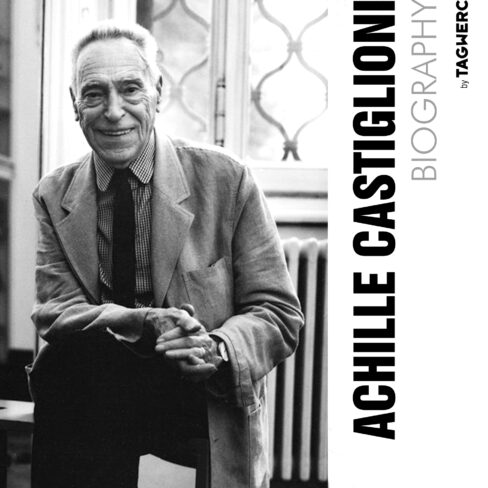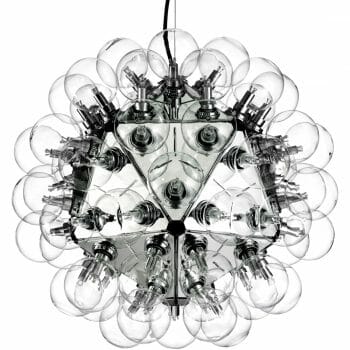
Biography of Achille Castiglioni
Achille Castiglioni is an Italian architect and designer who lived and worked in his hometown of Milan until his death. Until today, Achille Gastiglioni is mainly associated with a stool that reminds of a tractor seat. It is precisely this Mezzadro stool that was created rather accidentally in the 1950s. Castiglioni is active in the field of architecture, curates exhibitions and makes a name for himself above all in interior design. His designs for furniture, lighting and home accessories are design classics and are still produced today by manufacturers such as DePadova, Dino Gavina, Zanotti, Alessi, Stilnovo and Flos and are available at TAGWERC as licensed originals.
Castiglioni Architetti
On 16 February 1918, Lithuania declares its independence. The Republic of Lithuania is born. About two thousand kilometers to the southwest, Achille Castiglioni sees the light of day in Milan. Achille is the third son of the sculptor, painter and architect Giannino Castiglioni and his wife Livia Bolla. Achille Castiglioni completes his architectural studies at the Polytechnic University in Milan in 1944 and aspires to a career as an independent architect and designer. At the age of 26, he joines the architectural practice of his older brothers Livio (1911-1979) and Pier Giacomo (1913-1968), ready to revolutionise and thoroughly modernise architecture. The ‘Castiglioni Architetti’ are born.
From architecture to industrial design
When Livio leaves the architectural practice in 1952 to work in radio business, Achille and Pier Giacomo continue without him. Building commissions are rare in this post-war period, although the Castiglioni brothers, together with Luigi Fratino, are able to assert themselves against 16 other designs with their concept for the reconstruction of the Palazzo della Permanente. The building on Via Filippo Turati, designed in 1881 by Luca Beltrami in the Neoclassical Style, is extended by the Castiglioni brothers to include an office tower in the functionalist style and inaugurated in 1953. Three years later follows the Chiesa di San Gabriele Arcangelo in Mater Dei, a Catholic parish church and one of the few architectural projects by Castiglioni Architetti. Achille and Pier Giacomo Castiglioni not only design the building for the Chamber of Commerce and Industry in Milan, but also design parts of the interior at the same time. Thus, the Saliscendi pendant luminaire is born out of an intuition: a system of rollers makes it possible to move the luminaire upwards or downwards. With the change of position, the light intensity changes – both on the table and in the surroundings. Today, the Saliscendi pendant lamp is built by Stilnovo and is available at TAGWERC.
Castiglioni’s credo
The Castiglioni brothers recognise the signs of the times and switch to designing home accessories and interiors. A quote by Achille Castiglioni describes his design maxim: “Less is often more, especially when it comes to design”, and echoes the idea that “Less is more” by Ludwig Mies van der Rohe, head of the Bauhaus in Weimar and architect of Classical Modernism or Modernism in the 20th century. Unconventional stools such as Sella and Mezzadro (both 1957) are created, which put everyday objects – a bicycle saddle and a tractor seat – into new and surprising shapes and increase their utility value for the general public. To Achille Castiglioni’s own words: “Design is not just about aesthetics, it’s also about solving problems and improving people’s lives.” For his studies and as inspiration, Achille Castiglioni collects unusual everyday objects throughout his life, such as special tools and toys, which are still preserved today. In the ‘Studio Museo Achille Castiglioni’, the museum dedicated to the Milanese’s work and run by the ‘Fondazione Achille Castiglioni’, his collection fills entire wall cupboards.
Dynamic sitting
Design as a means to solve problems – Achille Castiglioni is known for putting himself into his designs and taking the user’s perspective. The Sella stool, for example, is one of the first dynamic seating furniture that invites the user to actively sit – long before dynamic seating furniture such as the Swopper, Sitness, Fitness stool & Co. When the Castiglionis set up their exhibition ‘Colori e forme nella casa d’oggi’ (Colours and Forms in the Home Today) in 1957 in the Villa Olmo in Como on Lake Como, it is a simple red tractor seat, mounted on a frame, which is placed in front of a desk – as a visitor’s chair, so to speak. What at the time appeared to be a kind of home accessory or quirky decorative object and met with little understanding from visitors, would twenty years later go into series production at Zanotta and go down in history as the ‘essence of Castiglioni’.
End of 1950, beginning of 1960
Undoubtedly the most creative period of the Castiglioni brothers has dawned and it is also the period in which some Italian interior manufacturers have their roots: Martinelli Luce (1950), Zanotta (1954), Flos (1962) – to name but a few. Especially with Flos, Achille and Pier Giacomo Castiglioni are closely connected, as their designs produced by Flos are the driving force that shape the reputation of the Italian company for innovative lighting design.
Floor lamp and pendant luminaire in one
Flos get off to a furious start in 1962 with Castiglion’s Arco arc lamp. The floor lamp is a pendant luminaire at the same time. A hybrid whose expansive metal arch is held by a 60-kilogram block of marble from the quarries of Carrara. The Taccia table lamp and the Toio floor lamp date from the same year. The latter consists of a car headlight enthroned on a steel rod, as well as the Pitagora espresso machine for the renowned manufacturer of portafilter machines La Cimbali. Other lamp designs produced by Flos follow: Parenthesi (1970), the Lampadina table lamp, the Noce table and wall lamp (both 1972), Aoy (1975), Bibip (1976), Frisbi (1978), Gibigiana (1980), Moni and Giovi (both 1982), Stylos (1984), Traxacum (1988), Brera (1992), Fucsia (1996) and Diabolo (1998).
Milan – stronghold of design
Castiglioni’s hometown of Milan, the second-largest city in Lombardy, is undoubtedly a center of design, where the ‘Salone del Mobile Milano’, the world fair for interior design, takes place. When the ‘Associazione per il Disegno Industriale’ (ADI), the association for industrial design, is founded in Milan in 1956, Achille Castiglioni is one of the founding members. But this is not the only way Gastiglioni makes a name for himself in the field of design. After receiving a teaching permit for ‘artistic design for industry’ from the ‘Ministero della Pubblica Istruzione’, the Ministry for Public Education, Castiglioni tells at the ‘Politecnico di Torino’ from 1969 to 1980. Afterwards, he holds a teaching position for industrial design, a full-time professorship, at the Politecnico of Milan until 1993.
Honorary doctorate for industrial design
Achille Castiglioni is awarded a large number of prizes, including nine Compasso d’Oro. He receives honorary awards, is an honorary member of various international design faculties and in 2001 is awarded an ‘Honorary Doctorate in Industrial Design’ by the Politecnico di Milano. The Museum of Modern Art (MoMA) in New York alone owns 14 of his design classics. Design museums all over the world show Achille Castiglioni’s designs: the Victoria and Albert Museum in London, the Museum of Applied Arts in Zurich, the State Museum of Applied Arts in Monaco, the Museo del Design in Prato, Umeleckoprumyslove Museo in Prague, Israel Museum in Jerusalem, The Denver Art Museum in the Texan capital, Vitra Design Museum in Weil am Rhein, the Museum of Applied Arts in Cologne and Hamburg.
Two heads on one body
In the midst of his success, 1968 came as a shock: one of the hardest blows of fate for Achille Castiglioni is certainly the early death of his brother Pier Giacomo. As the Castiglioni Architetti company is really taking off, Pier Giacomo dies in 1968 at the age of only 55. “Like two heads on one body,” is how the ‘Corriere della Sera’, Italy’s highest-circulation daily newspaper, describes the relationship between the two brothers – not only in family terms, but above all in professional terms. Achille doesn’t let on, just carries on and pretends that Pier Giacomo is still there, sitting by his side as he had all those years before.
Career as lecturer and professor
What many people don’t know at that time: At this point Achille wants to give up. “It came so suddenly! And I didn’t know how to organise my work alone, without my adversary, without him as a conversation partner,” says the designer. For a long time, he helps himself by “just pretending he was still there”. But secretly he thinks about quitting, as Achille reveals many years later. It is at this point in Castiglioni’s life that he begins a career as a lecturer, passing on his visions and visionary design approaches to budding architects and industrial designers in clear and practical lectures. The auditorium is packed when Castiglioni – armed alone with a broomstick – demonstrates how to move a hundredweight-heavy block of marble with ease. His lectures are popular and, as he used to do with Pier Giacomo, he now conducts the dialogue – although with a different intensity – with his students. “Design is a collaborative effort and it is important to include the opinions and suggestions of others,” says Achille Castiglioni.
Essenza di Gastiglioni
When the grand master of industrial design dies in Milan on 6 December 2002, the Who’s Who of the architecture and design scene worldwide express their condolences: Michele De Lucchi, Philippe Starck, Sir Norman Foster, Ross Lovegrove, Ettore Sottsass – to name but a few. His visionary designs are still legendary today. Achille Castiglioni design is immortalised in the leading design museums – at TAGWERC you get the original Achille Castiglioni design for the private and professional ambience and thus the manifestation of Achille Castiglioni’s credo directly with it: “We wanted to get to the actual, to the essence, by omitting.”
Achille Castiglioni Design Classics at TAGWERC
At TAGWERC, you can get the Achille Castiglioni Design Classics collection. Online, at the TAGWERC Design STORE, experience a curated selection of Achille Castiglioni design objects. For all Achille Castiglioni objects not listed here, we will be happy to provide you with an individual offer.
Designs
- 1957
Seating furniture ‚Sella‘ for Zanotta - 1957
Seating furniture ‚Mezzadro‘ for Zanotta - 1960
Seating furniture ‚Lierna‘ for Gavina - 1960
Armchair ‚Sanluca‘ for Gavina - 1962
Lamp ‚Gatto & Gatto Piccollo‘ for Heisenkeil ( today Flos ) - 1962
Spoon ‚Sleek‘ for Kraft and Alessi - 1962
Lamp ‚Toio‘ for Flos - 1962
Lamp ‚Taccia‘ for Flos - 1962
Lamp ‚Arco‘ for Flos
Exhibitions
- 1957
‘Colours and shapes in today’s home’, Villa Olmo, Como - 1963
‘Waterways from Milan to the Sea’, Palazzo Reale, Mailand - 1965
‘The Inhabited House’, Palazzo Strozzi, Florenz - 1984
‘The Inhabited House’, Palazzo Strozzi, Florenz
‘Achille Castiglioni’, Museum für Angewandte Kunst, Wien - 1988
‘The Cities of the World and the Future of Metropolises’, 17th Triennale, Art Palace, Mailand - 1995
‘A la Castiglioni’, Centre d’Art Santa Mònica, Barcelona
Awards
- 1955
UPremio Compasso d’Oro for the Luminator lamp - 1960
Premio Compasso d’oro for the chair T12 Palini - 1962
Premio Compasso d’oro for the Pitagora espresso machine - 1964
Premio Compasso d’oro for the Spinamatic beer tapper - 1967
Premio Compasso d’oro for one headphone - 1979
Premio Compasso d’oro for the lamp Parentesi - 1979
Premio Compasso d’oro for the hospital bed Omsa/li> - 1984
Premio Compasso d’oro for the Dry cutlery




